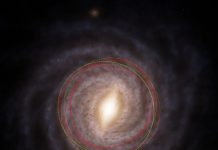
Ever heard of a star having waves?
Just like our oceans, a unique star system is showing us gigantic waves, but these are much, much bigger than anything on Earth!
This special star system is called a “heartbeat star.”
Think of these stars like dancing partners. They come close, then move away in a repeating pattern, just like our heartbeat.
As they come close, the gravity they exert on each other creates tides. Imagine how the Moon pulls on Earth to make ocean tides, but this is happening between stars in space.
Now, here’s where it gets super interesting. One of these heartbeat stars has waves that are mind-blowingly huge.
How big? Imagine stacking three of our Suns on top of each other – that’s the height of these waves. Every time its partner star gets close, it creates these massive waves which crash down, just like ocean waves do on a beach.
This star has been lovingly named the “heartbreak star.”
Morgan MacLeod, a scientist at Harvard & Smithsonian, described the waves on this star as so powerful that the energy they release could completely destroy our Earth hundreds of times. That’s a lot of energy!
But don’t worry, this isn’t close to us. Instead, it gives astronomers a front-row seat to see how massive stars interact. It’s kind of like watching a big cosmic dance up close.
You might be asking, how did scientists find these stars? A telescope named Kepler, made to find distant planets, first noticed these heartbeat stars. It detected small changes in their brightness, like tiny heartbeats.
But our heartbreak star was different. Its changes in brightness were dramatic, swinging up and down by a whopping 20%.
For comparison, most heartbeat stars only change by about 0.1%.
To understand this crazy star better, Morgan MacLeod made a computer model. This model showed that the waves on the star were tall, smooth, and organized at first, just like our ocean waves.
But as they moved, they broke and crashed, making a big, glowing mess.
This mess has a big effect. The star starts to spin faster, and bits of the star are thrown out, making it glow. Every month, when the two stars come close, a new giant wave forms. Over time, these waves have made the star’s middle, or equator, puff out more than its top and bottom, by about 50%.
This star might be unique, but scientists think there are others like it.
Among the 1,000 or so heartbeat stars discovered, around 20 show big changes in brightness like our heartbreak star. MacLeod and other scientists want to find more of these stars to learn more about their glowing, crashing waves.
In the end, we’re pretty lucky to see this star’s giant waves. It’s like catching a surfer ride a once-in-a-lifetime wave.
By studying these waves, scientists hope to learn more about stars and how they grow and change over time. So next time you watch waves at the beach, remember, there’s a star out there with its own gigantic waves!
Follow us on Twitter for more articles about this topic.
Source: Harvard-Smithsonian Center for Astrophysics.



